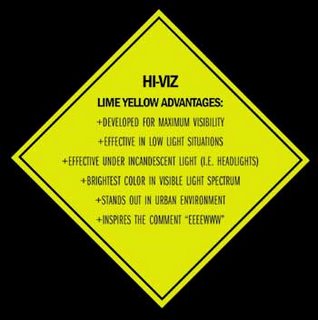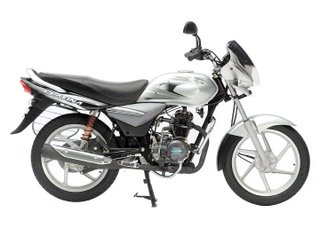Continued from here
General Notes
Acute Mountain Sickness is a potentially fatal disease, so don't take it lightly. To give you a quick physiological background. The depleted oxygen levels cause the body extreme discomfort. But you knew that. Symptoms:
- Piercing, throbbing, persistent headaches. A number of riders on our trip had these. They seemed not to respond too well to aspirin/paracetamol. The only way to fight them seemed to be to grit your teeth and get on with it. There are cases (I referred to a British medical website) where AMS headaches have caused fatal errors of judgement. You've been warned.
- Nausea This usually follows the headaches and makes the whole situation very nasty, indeed. Again, medicines don't help too much.
- Unconsciousness This is a serious situation. You need to get the patient on oxygen, to a lower altitude or to the nearest army medical camp (Pang is the usual one) for instant and immediate medical attention.
Avoiding AMS is quite easy, but not a sure shot. Drink loads of fluids. I'm talking litres and litres of the stuff. I was drinking five litres of water by lunch. Take small sips. It also means that you should always have that much water around. I drank regular water filled in at Dhabas. They say it's close enough to mineral water.
Avoid too much, prolonged physical effort. I'm saying take long breaks, walk slowly and whenever your breath becomes even slightly laboured just stop, sit down and recover. I once needed to take a break while carrying two 1 litre bottles full of water to my tent from the mess tent. The distance was about 45 feet between the two. This was at Sarchu, on the Leh side of the Baralachla. And always, always breath deeply. Sort of like a Baba Ramdev Pranayam.
And eat lots of food. You will be consuming energy at a phenomenal rate, so eat. Ideally, don't drink [alcohol] on the road to Leh. It does not help. This is especially crucial if you already have headaches. There are two medicines which normally help:
- Diamox This takes some time to start working, so hill-experts advice starting to take it three-four days before you hit the altitudes. Please check with your doctor
- Lasix This is the quicker acting one. Warning: Lasix will change your bladder setting to hyperactive. You will want to pee every ten minutes or so. That means, you have to keep drinking to replenish the losses. Also, there isn't much time between feeling like 'I want to go' and wet trousers, so hurry out of the car. The ladies do have a tough time with bodily functions and privacy out in the open, but there really isn't much you can do. The girl with us would basically go around the next corner (and we would not) or climb over to the other side of the nearest hillock.
- More information on AMS: Use the following links
Travel Doctor's guide to Acute Mountain Sickness
ISMM's Non-physician guide to AMS
[The usual disclaimers apply. Please check with your physician/doctor etc before you take any medication whatsoever. No lawsuits, or abuse will be entertained on this count.]
Oxygen It might seem excessive, but carrying a medical oxygen cylinder is a good idea. You can rent one, I think, and return it should not have needed it (thank god). But you have to reserve its use for emergencies. A splitting headache is not an emergency. Oh and remember to get the mask.
Don't linger on top The top of a mountain pass can be an enthralling place to be. Especially if the weather is good. But don't linger too long. The oxygen levels are really low and it will cause/worsen AMS very fast. While you're there, breathe deeply and fill your lungs. Move slowly, don't yell or shout and get down quickly.
Crossing passes Your worst enemies on the mountains are weather and water. Mountain pass weather is as fickle as a woman's mind. Respect it. Especially Baralachla. That mountain pass is the second out of Manali and the most dangerous in the entire region. It kills the unwary with unfailing regularity every year.
Passes are crossed in the morning for best results. The ideal window is between ten and twelve in the forenoon. After that the weather (whatever is going on) gets worse. At four, the Army will physically close the passes and suspend all rescue activity. You don't want to be stuck on top.
The other reason from crossing between ten and twelve is the water. As the day gets on, the meltwater flows gather strength. A trickle in the morning gurgling across the road in the morning can easily turn into a gushing torrent by the afternoon. Baralachla, once again, has some of the deepest water crossings - at midday they'll wash your axles down. Here are some sites with water crossing tips
The driving across is never fast, but always steady. Don't rush through the pass, keep a steady rhythm. And keep an eye out for snow/ice/rock that could be ready to fall from above on to your vehicle. At Chandra Tal, I saw the engine noise of a truck cause a minor rock fall.
 Crossing water
Crossing water There's a whole bunch of 4x4 enthusiast websites where you can get tips on crossing water. Read them. Always cross at a steady pace, not too fast or slow. And never, ever have two vehicles in the water at the same time. And be ready to have to enter the water to help any stranded vehicles, people. That's anyone. Which means some towels, extra clothes, socks and shoes kept handy.
 Mountain etiquette
Mountain etiquette Stop to help anyone who seems to be in trouble. Help in any reasonable way you can. And always let bikers pass. Heh heh. Also, sometimes the poor labourers of the BRO will ask for water, or a lift down the road. If you're comfortable, give it to them. They're just homesick Bihari labourers, living in a very hostile place. Wave to them as often as you can.
Night driving is fine up to Chandigarh, after that, I don't really recommend it. Chandigarh-Manali is just too beautiful to waste. And Manali-Leh is just too much of a hazard.
Weather When it gets worse, it gets really, really bad. Carry full rain gear (rain coat etc) ideally not to tight, so you can wear warm stuff underneath. On the mountain tops, rain will usually drag fog and snow into the mix. Drive slow and hope you don't hit black ice.
Food Carry a couple of days food in the car. Maggi type stuff is fine, personally, I prefer Top Ramen or Wai Wai; the wife prefers Maggi. The reason is that when bad weather closes passes or causes landslides, it blocks everything. Your luxury camp can (ours did) run short of supplies, then things can get tense. Closed roads also means hundreds of stuck people, all vying for the same resources. Having your own is an inestimable advantage. Same goes from drinking water.
 Pangong Tso and KhardungLa
Pangong Tso and KhardungLa are both open to Indians, but you need to get a permit. That means a goverment office with days and hours of operation...
Continued here
 Yamaha is all set to launch a new 125cc motorcycle called the Gladiator. A friend in the business called yesterday to say this, 'I rode it. It has a five-speed gearbox and I managed to easily see 100 kph in fifth. It feels good to ride.' I also hear that journalists are getting a preview in the first week of May. Is this the bike that marks the return of Yamaha? The Gladiator is rumoured to have a normal fairing on the Fazer's lines, which is nice. Obviously some stickering will happen (the Fazer was naked, so stickers will distinguish the Glad). I hear that the engine is derived from the Fazer's but is muscled up to return a more performance-oriented feel. If it does get the Fazer's ergos, it will be the most comfortable 125cc motorcycle on sale in India. Can't wait. Oh, and nothing of the Two Gladiator concepts from the Auto Expo made it to the bike as far as I can make out. Fortunately, I happen to think that's a good thing.
Yamaha is all set to launch a new 125cc motorcycle called the Gladiator. A friend in the business called yesterday to say this, 'I rode it. It has a five-speed gearbox and I managed to easily see 100 kph in fifth. It feels good to ride.' I also hear that journalists are getting a preview in the first week of May. Is this the bike that marks the return of Yamaha? The Gladiator is rumoured to have a normal fairing on the Fazer's lines, which is nice. Obviously some stickering will happen (the Fazer was naked, so stickers will distinguish the Glad). I hear that the engine is derived from the Fazer's but is muscled up to return a more performance-oriented feel. If it does get the Fazer's ergos, it will be the most comfortable 125cc motorcycle on sale in India. Can't wait. Oh, and nothing of the Two Gladiator concepts from the Auto Expo made it to the bike as far as I can make out. Fortunately, I happen to think that's a good thing.





 You already know that the 2006/7 Honda Goldwing offers a factory-installed airbag that protects the rider from crashing through the fairing and imparing their intercoms, CD players, navigation systems, airconditioning, hairdos etc.
You already know that the 2006/7 Honda Goldwing offers a factory-installed airbag that protects the rider from crashing through the fairing and imparing their intercoms, CD players, navigation systems, airconditioning, hairdos etc.









 [
[

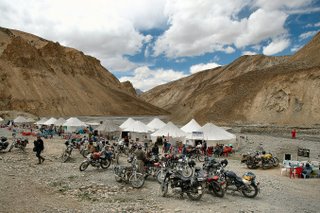





 Bharatpur City (misnomer. A collection of tents is what you're looking for) is a relief, for it means you've completed the Bara-La descent. The road to Sarchu is paved and gorgeous. But don't speed. The tarmac hides fairly big undulations (I was thrown up from the seat repeatedly until I learned).
Bharatpur City (misnomer. A collection of tents is what you're looking for) is a relief, for it means you've completed the Bara-La descent. The road to Sarchu is paved and gorgeous. But don't speed. The tarmac hides fairly big undulations (I was thrown up from the seat repeatedly until I learned). Sarchu starts with a meadow that has a bunch of tourist tent camps on your right. Your tent should be here. More tents, more downmarket are further down the road, about 5 km, where there is another tourist registration office, dhabas, tents and some Army presence.
Sarchu starts with a meadow that has a bunch of tourist tent camps on your right. Your tent should be here. More tents, more downmarket are further down the road, about 5 km, where there is another tourist registration office, dhabas, tents and some Army presence.
 The plains are beautiful and up high. Stop to click, sigh etc, but remember to keep drinking water.
The plains are beautiful and up high. Stop to click, sigh etc, but remember to keep drinking water.

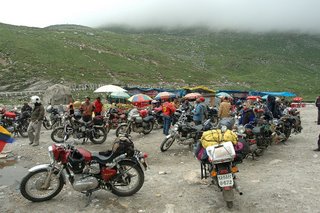

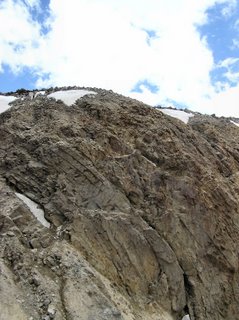
 ends
ends
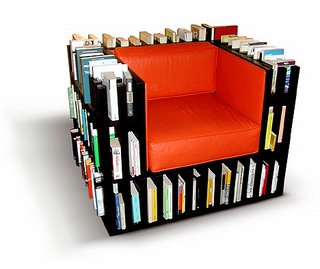
 Yes, it still is the land of yellow Ambassador cabs,
Yes, it still is the land of yellow Ambassador cabs,
 Yes, we've all seen pics like this before. But the
Yes, we've all seen pics like this before. But the



